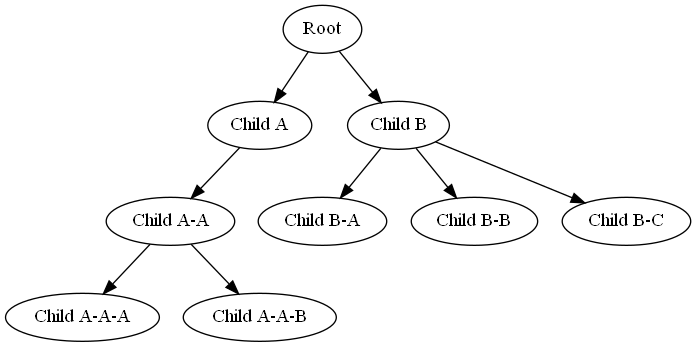Diagramming Org-Mode Headline Hierarchies with Org-Babel
A while back the need arose to generate graphs of some hierarchies, so I thought it would be convenient to generate diagrams from org-mode headlines using Graphviz. Here’s an org-mode document capable of generating graphs using org-babel, using Elisp to convert the headline structure into JSON and Python to convert that JSON into a graphviz diagram:
#+begin_src emacs-lisp :results silent
(require 'org-element)
(defun pygraphing/get-headline-structure(id)
(json-encode (pygraphing/get-headline-descendents id)))
(defun pygraphing/get-headline-by-id(id)
"Returns headline from ID"
(let ((header nil))
(org-element-map (org-element-parse-buffer) 'headline
(lambda (hl)
(when (string= (org-element-property :ID hl) id)
(setq header hl))))
header))
(defun pygraphing/get-headline-tags(id)
"Returns tags of item by ID"
(let (
(header (pygraphing/get-headline-by-id id)))
(when header
(list
:ID (org-element-property :ID header)
))))
(defun pygraphing/get-headline-children-ids(id)
"Returns child ids of a headline by its ID"
(let ((header (pygraphing/get-headline-by-id id)))
(delq nil (mapcar (lambda(child)
(org-element-property :ID child))
(org-element-contents header)))))
(defun pygraphing/get-headline-descendents(id)
"Returns all descendents of headline"
(let ((header (pygraphing/get-headline-by-id id)))
(when header
(let ((children (pygraphing/get-headline-children-ids id)))
`((header . ,(org-element-property :raw-value header))
(tags . ,(pygraphing/get-headline-tags id))
(children . ,(delq nil (mapcar
(lambda(childID)
(pygraphing/get-headline-descendents childID))
children))))))))
#+end_src
#+begin_src python :results file :dir (org-attach-dir) :var result=(pygraphing/get-headline-structure "1ff8ce7d-be78-4bd2-afa0-05be1fb9d9d2")
import graphviz
import json
dot = graphviz.Digraph()
root_header = json.loads(result)
def graph_header(header,parent=None):
nodeName = header["header"]
dot.node(nodeName)
if parent:
dot.edge(parent,nodeName)
if header["children"]:
for child in header["children"]:
graph_header(child,nodeName)
graph_header(root_header)
return dot.render(outfile="diagram.png")
#+end_src
* Root
:PROPERTIES:
:ID: 1ff8ce7d-be78-4bd2-afa0-05be1fb9d9d2
:END:
** Child A
:PROPERTIES:
:ID: ce64aa4c-3ed1-4535-ab97-7b486884ae05
:END:
*** Child A-A
:PROPERTIES:
:ID: 836d5265-7860-4a36-ab9e-bec1ca2bffd8
:END:
**** Child A-A-A
:PROPERTIES:
:ID: 3f0d25a4-4b1a-49ff-8862-22f2d83631b0
:END:
**** Child A-A-B
:PROPERTIES:
:ID: a53df412-244a-4c35-9dcb-0466bb2d2d40
:END:
*** Child A-B
** Child B
:PROPERTIES:
:ID: 3fc2535b-3fa8-4f05-bfb1-9735bc88d2d8
:END:
*** Child B-A
:PROPERTIES:
:ID: 96b0087c-306f-4b7c-92b2-bcc786bb1491
:END:
*** Child B-B
:PROPERTIES:
:ID: 431857d5-6e64-4bb3-aa67-8eb9369fb776
:END:
*** Child B-C
:PROPERTIES:
:ID: a8f166e1-12e6-4dda-85e7-4d0668dce02e
:END:
(Note: Before continuing, make sure you have the graphviz package installed for python with python -m pip install graphviz)
With this org document, you can now run M-x org-babel-execute-src-block (Usually C-c C-C) on the Elisp and Python blocks, producing the following graph:

This setup could certainly be improved upon, perhaps by making the Elisp portion a package and by adding some more headline properties to features such as multiple parents, but it’s definitely useful for flexibly generating some quick and dirty graphs.